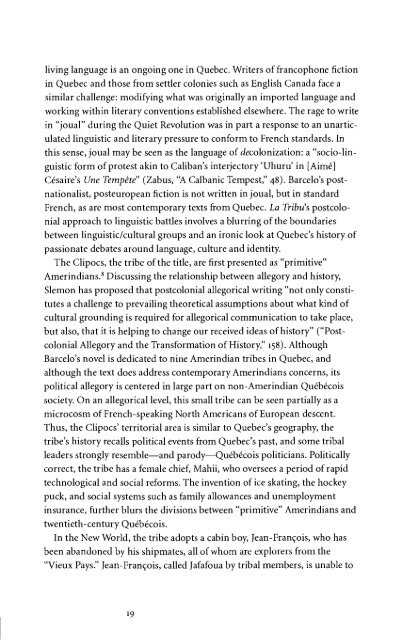The Carpathians - University of British Columbia
The Carpathians - University of British Columbia
The Carpathians - University of British Columbia
You also want an ePaper? Increase the reach of your titles
YUMPU automatically turns print PDFs into web optimized ePapers that Google loves.
living language is an ongoing one in Quebec. Writers <strong>of</strong> francophone fiction<br />
in Quebec and those from settler colonies such as English Canada face a<br />
similar challenge: modifying what was originally an imported language and<br />
working within literary conventions established elsewhere. <strong>The</strong> rage to write<br />
in "joual" during the Quiet Revolution was in part a response to an unarticulated<br />
linguistic and literary pressure to conform to French standards. In<br />
this sense, joual may be seen as the language <strong>of</strong> decolonization: a "socio-linguistic<br />
form <strong>of</strong> protest akin to Caliban's interjectory 'Uhuru' in [Aimé]<br />
Césaire's Une Tempête" (Zabus, "A Calbanic Tempest," 48). Barcelo's postnationalist,<br />
posteuropean fiction is not written in joual, but in standard<br />
French, as are most contemporary texts from Quebec. La Tribus postcolonial<br />
approach to linguistic battles involves a blurring <strong>of</strong> the boundaries<br />
between linguistic/cultural groups and an ironic look at Quebec's history <strong>of</strong><br />
passionate debates around language, culture and identity.<br />
<strong>The</strong> Clipocs, the tribe <strong>of</strong> the title, are first presented as "primitive"<br />
Amerindians. 8 Discussing the relationship between allegory and history,<br />
Slemon has proposed that postcolonial allegorical writing "not only constitutes<br />
a challenge to prevailing theoretical assumptions about what kind <strong>of</strong><br />
cultural grounding is required for allegorical communication to take place,<br />
but also, that it is helping to change our received ideas <strong>of</strong> history" ("Postcolonial<br />
Allegory and the Transformation <strong>of</strong> History," 158). Although<br />
Barcelo's novel is dedicated to nine Amerindian tribes in Quebec, and<br />
although the text does address contemporary Amerindians concerns, its<br />
political allegory is centered in large part on non-Amerindian Québécois<br />
society. On an allegorical level, this small tribe can be seen partially as a<br />
microcosm <strong>of</strong> French-speaking North Americans <strong>of</strong> European descent.<br />
Thus, the Clipocs' territorial area is similar to Quebec's geography, the<br />
tribe's history recalls political events from Quebec's past, and some tribal<br />
leaders strongly resemble—and parody—Québécois politicians. Politically<br />
correct, the tribe has a female chief, Mahii, who oversees a period <strong>of</strong> rapid<br />
technological and social reforms. <strong>The</strong> invention <strong>of</strong> ice skating, the hockey<br />
puck, and social systems such as family allowances and unemployment<br />
insurance, further blurs the divisions between "primitive" Amerindians and<br />
twentieth-century Québécois.<br />
In the New World, the tribe adopts a cabin boy, Jean-François, who has<br />
been abandoned by his shipmates, all <strong>of</strong> whom are explorers from the<br />
"Vieux Pays." Jean-François, called Jafafoua by tribal members, is unable to

















